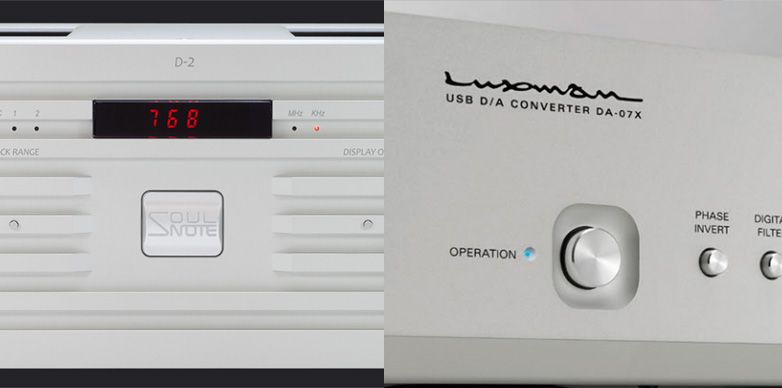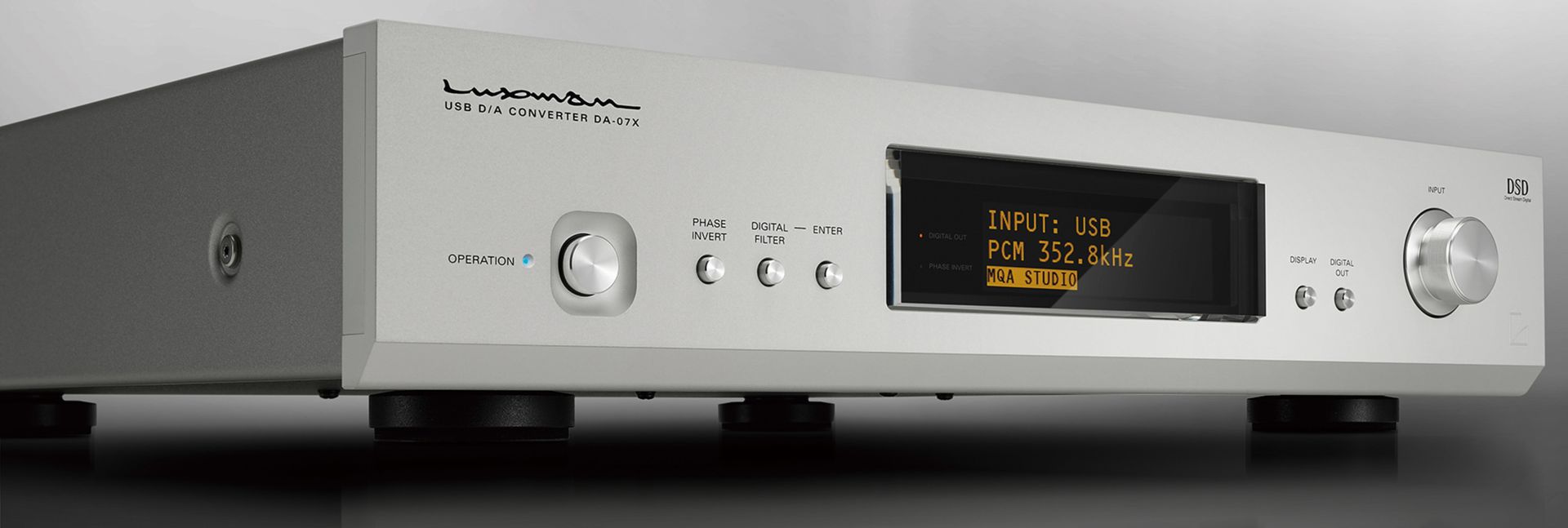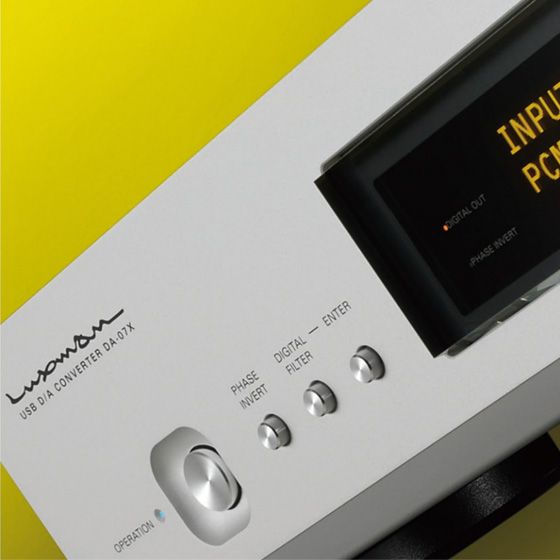
These are two of our favourite DACs at the moment, so we thought a head-to-head comparison would be useful to assist choosing between the two.
Both units have all of the usual digital inputs and have analogue outputs on both RCA or XLR (with switchable pin change for XLR on the Soulnote). However, we have always preferred the sound picture when using the non-balanced RCA circuit for its more holographic soundstage and less forward presentation.
Both of these units are chip-based, delta-sigma implementations. All of the expected digital inputs are present: S/PDIF, TOSLINK, Optical or Coaxial, and AES/EBU. As usual, Optical has a maximum resolution of 24 Bits 96 kHz, Coaxial and AES/EBU offers 24 Bits 192 kHz.
To get the maximum resolution on both the Luxman and the Soulnote DACs, USB will need to be used as this will deliver PCM up to 768 kHz and 32 bits and DSD up to 22.5 MHz.
Our listening tests were done using both Luxman 509z and Soulnote A2 amplifiers through GutWire interconnects, speaker cable, power cords, USB and digital coaxial cables.
The speakers chosen for their neutrality and resolving transparency were the Kudos Titan 606 and the Fyne F702SP, with the addition of the new Fyne super-tweeter.
The majority of the listening evaluations were using CD for its superior sound stage abilities and resolution. We used the Luxman D10x as a CD transport, to facilitate this. The performance from the Tidal streaming service, was judged too using Luxman’s own streamer, the NT-07, as well as the Innuos ZENith Mk3 and the ZENith Next-Gen.
All power cords were connected from a Puritan PSM-1512 Special Edition mains purification distributor.

The Luxman DA-07x
The Luxman DA-07x is one of the newer models to our studio. It is an extremely well-built unit, weighing in at a hefty 13 kgs, in a fairly discrete chassis of only 92 mm in height, though around 40cm deep. It has a small dimmable screen on the front, showing input and the sampling rate being played, as well as a toggle to quickly switch inputs.
The digital circuitry is gleaned from their D-07x CD player, an excellent reference player at this price point, coupled with their discrete analogue output stage. The DAC chip itself is interesting, as this is from the range of ROHM semiconductors that has been developed from its inception, with music as a focus. Indeed, the range is called the MUS-IC series. The DA-07x uses two of their flagship chips, one per channel in dual-mono configuration.
The reference clocking system has two ultra-low phase noise clock modules with high precision and low jitter, reducing noise near the oscillation frequency to a minimum.
The DA-07x features Luxman’s highly regulated power supplies, with three separate OI core type transformers, regulation systems and bespoke filter capacitors.
The output stage uses discrete components as opposed to cheaper surface mount items used in lesser DACs. This is a more costly approach but the output stage is the interface with the amplifier and is a very important part of the sonic performance of the DAC. This can be an oversight in many DAC implementations.
Coupled with the new Luxman NT-07 Streamer, the two make for a stylish and high-performing combination.
Our listening session was using Filter D1 on the unit, which was our preferred option.

The Soulnote D2
The chassis for the D2 is far more substantial than that of the Luxman at 160mm in height and weighs in at 17kgs. This looks and feels more like an amp than a DAC. It has the Soulnote distinctive, CNC-machined chassis with a ribbed appearance. This housing is shared by the other Soulnote 2 Series components, the A2 amplifier and the E2 phono-stage. The internal volume is used effectively to keep sensitive components away from each other, minimising noise.
The DAC in this instance uses 4 of the ESS Sabre ES9038PRO chips, with 2 per channel in true differential configuration.
Listening can be done in NOS (non-oversampling) mode or through filters. Our favourite is NOS used for most of our listening but we also thought FIR Filter 2 had some merits.
This unit can be used in stereo mode, as in this listening test, but can also be used in mono configuration where two DACs can be used, one for each channel. In this configuration, stereo separation is practically infinite.
The digital boards are independent structures with one portion connected to the rear panel, allowing for upgrades in the future. The analogue output stage uses separate boards with discrete, selected components on them, ensuring optimal information transfer in order to maximise the sound purity. These are arranged in a dual mono configuration that fully isolates each channel, including the power supply rectifiers.
The internal clock relies on a high performance TCXO boasting stunning phase noise reduction (-121 dB at 10 Hz offset). An external clock could also be used but, with the standard unit’s excellent performance, there would be little point.
Listening test results
The first thing noted was that the Luxman has more density in the sound field with a little more depth than the Soulnote. However, the Soulnote counters with the way it presents the placement of items more accurately within the soundstage. Both DACs produce a wide and deep sound images but with the Soulnote being marginally more forward.
Both the DA-07x and the D2 DACs produce clean and textured bass, with the Luxman being slightly warmer in its bass presentation than the Soulnote. The impression is that the Soulnote sound is slightly more accurate but less forgiving of bad recordings than the Luxman.
Using some well recorded CDs of jazz, rock, and blues genres, rhythmic presentation and coherence appeared to be slightly faster on the Luxman but the Soulnote gave the illusion of a great flow to the music. Dynamic shifts and transient attacks are handled superbly well, with ease, by both.
Classical recordings of piano and violin, often difficult instruments to render naturally with digital recordings, were reproduced with excellent textured and natural timbres. The Luxman delivers slightly more high frequency information with the Soulnote being slightly smoother in this area. This may suit more forward sounding audio components of which there are many examples in today’s marketplace.
Both of these DACs reflect some of the best sounds at the higher end of the market and also demonstrate the care and attention to the quality of the musical reproduction that artisan Japanese manufacturers bring to audiophiles seeking accuracy and less colouration. There is no wrong choice, both are excellent sounding DACs. The choice would be more down to system synergy and personal preference of the delivery. Plus whether your equipment support allows for a DAC of the Soulnote D2’s dimensions.
We have both of these components on demonstration in our studio. As ever, the advice is that a carefully curated audition is recommended to make the final choice.
Soulnote D2 DAC - £7,700
Luxman DA-07x DAC - £5,800
Additional components used for this comparative test
Amplification
Soulnote A2 integrated amplifier –
£6,300
Luxman L-509Z integrated amplifier – £11,000
Speakers
Kudos Titan 606–
£12,000
Fyne F702SP (Special Production) with the Fyne SuperTrax Super-tweeter – £12,000 and £3,000 respectively
CD player
Luxman D10X CD player – £15,000
This was used as a CD transport for this testing and was connected via the Coaxial Digital output
Streamers
Innuos ZENith Mk3 – £4,800
Luxman NT-07 –
£6,500
Innuos ZENith Next-Gen using the optional PhoenixUSB Lite output board – £15,200
Mains
All equipment was run from a Puritan Audio 1512 Special Edition 12-way mains distributor and purifier – £2,795
All signal cables and power cords were from GutWire Cables. Typically Uno-S interconnects, Chime Cube speaker cables, Pure Cube and Air Cube power cords.


